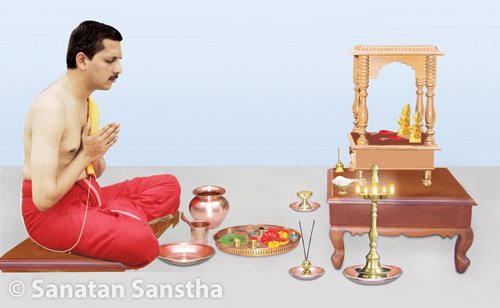
Puja of Deities is an easy way of abiding by achars (Conducts) set by Dharma to facilitate regular sadhana (Spiritual practice) of a worshiper. The basis of sagun (Materialised) upasana (Spiritual practice done with the mind) as per Hindu Dharma is the puja (Ritualistic worship) of Deities.
Today, what we see around is that in the name of puja, people just pour water quickly over an Idol, apply tilak of gandha (Sandalwood paste), offer some flowers and wave an incense-stick. However, can this hurried act be ever called puja of God, the one who takes complete care of our sustenance ? Why should God shower His grace upon us ? If we honour God by performing His puja in an appropriate manner, just as the respectful way in which we treat a guest, then God will be pleased with us and shower His abundant grace upon us.
The scriptures have taught us to abide by Dharma (Righteousness) in a ritualistic and bhav (Spiritual emotion) enriched manner by teaching us to worship God in sixteen sequential steps, such as invoking God, offering Him a seat, offering Him water to wash His Holy feet etc. Performing puja in this manner is known as Shodashopachar puja (Puja involving sixteen specific substances). Of these sixteen upachars, five upachars – Applying gandha, Offering flowers, Waving dhoop (Frankincense), Arati, Offering Naivedya (Food offered to the Deity as part of puja) form the Panchopachar. If it is not possible to perform Shodashopachar puja, Panchopachar puja can be performed.
We get the benefit of sankalpa-shakti (Energy of resolve) of our omniscient Sages only if we perform puja as advised by our scriptures. While performing puja as mentioned in the scriptures, utmost devotion and bhav are equally important. If there is a lack of love and devotion for God while performing puja, then it does not reach Him; for, God yearns for bhav. It is true that it is difficult for an ordinary devotee to develop bhav suddenly; however, if attempts are made to understand the science underlying various acts in puja, it will help in developing faith in the puja and consequently, the Deity. This faith in turn will develop into bhav.
1. Hindu Dharma is based on sagun upasana
Fundamentally, Hindu Dharma is based on karmakanda, meaning, on sagun. The first part of the Shodashopachar puja (Upachar 1 to 8) is the upwards illusory progress of the jiva from the Kunḍalini (Spiritual energy), with the objective of attaining the nirgun (Non-materialised). The concluding part of the puja (Upachar 9 to 16) is the actual progress towards the nirgun through advait (Non-duality) for the purpose of completing the task. ‘Illusory progress’ means. that due to fluctuation of bhav and emotions of the jiva during the sagun and nirgun progress, it wavers in an unstable manner. At times, there is realisation of the dvait (Duality), while at other times, there is attraction to the advait. Such a state of mind results in some decisions and some hesitations. Through all this, God makes the jiva effectively realise that Maya (The Great Illusion) is like a mirage; hence, this is an ‘illusory world’.
2. Importance of performing puja
A. The Deity Principle is attracted towards an Idol due to its specific form; whereas,
this Principle gets awakened due to the sanskars (Subtle impressions) such as puja etc.
H.H. Pagnis Maharaj consecrated an Idol at one place. Due to its form, it already had 2% Deity Principle. He performed puja of the Idol everyday. As a result of these regular sanskars, the Deity Principle in the Idol awakened further and reached 5%. The Deity Principle is attracted to an Idol due to its form; whereas, due to sanskars such as puja, the Deity Principle in it is awakened. If the sanskars are performed with bhav, the Deity Principle in the Idol enhances.
B. Obtaining the Deity’s grace
Puja pleases a Deity and hence, it becomes easier to obtain the Deity’s grace.
C. The Chaitanya (Divine consciousness) in the worshiper increases
By performing puja, the worshiper imbibes the Deity Principle. It reduces the proportion of Raja-Tama components in him and helps increase Chaitanya.
D. Sattvik (Sattva-predominant) waves imbibed
from the puja help in performing various activities throughout the day.
E. Purification of the environment
Puja helps increase the sattvikta of the environment.
3. Why should we try to understand the science underlying puja ?
Only when a worshiper understands the science underlying any act pertaining to puja, he is able to perform the act with complete concentration. Concentration helps in developing bhav, and thus the jiva understands the real principle underlying ritualistic worship. A karma that is directly associated with the puja and is based on Dharma, makes us realise the intention of God, and through that intent, the associated cause-effect-relationship. Therefore, to understand God’s cause-effect-relationship, we have to take the help of actual karma in the ritual.
The underlying bhav of a jiva to obtain Chaitanya from any act depicts the intent, meaning, it takes the jiva to meritorious karma. The resultant grace of God is the fruit that the jiva obtains from God’s cause-effect-relationship, meaning, God’s intent. Later, as this jiva performs every karma with a bhav of generating Chaitanya, the sanskars (Subconscious impressions) on its subconscious mind are eliminated in a short period, and the jiva is purified.

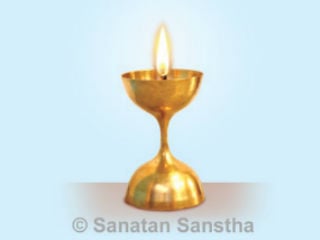 Waving a lit lamp symbolizes puja of Deity with Atmajyoti
Waving a lit lamp symbolizes puja of Deity with Atmajyoti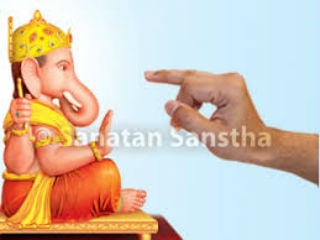 Benefits of applying gandha followed by offering of haldi and kumkum to Deities
Benefits of applying gandha followed by offering of haldi and kumkum to Deities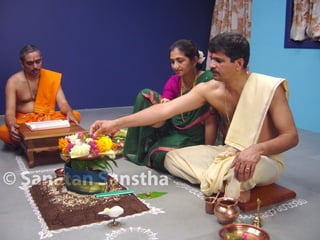 What are the benefits obtained from Puja preparations?
What are the benefits obtained from Puja preparations?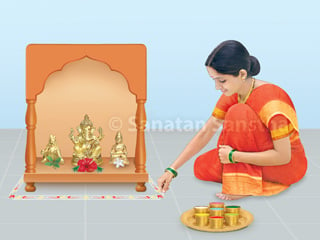 Importance of drawing Rangoli as a part of Puja preparations
Importance of drawing Rangoli as a part of Puja preparations Sounding of a conch at the commencement of a puja
Sounding of a conch at the commencement of a puja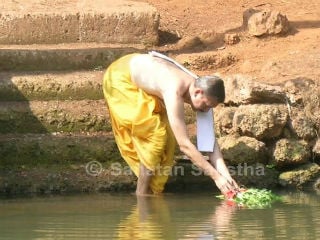 Importance of removing nirmalya from an Idol or a picture of a Deity with spiritual...
Importance of removing nirmalya from an Idol or a picture of a Deity with spiritual...